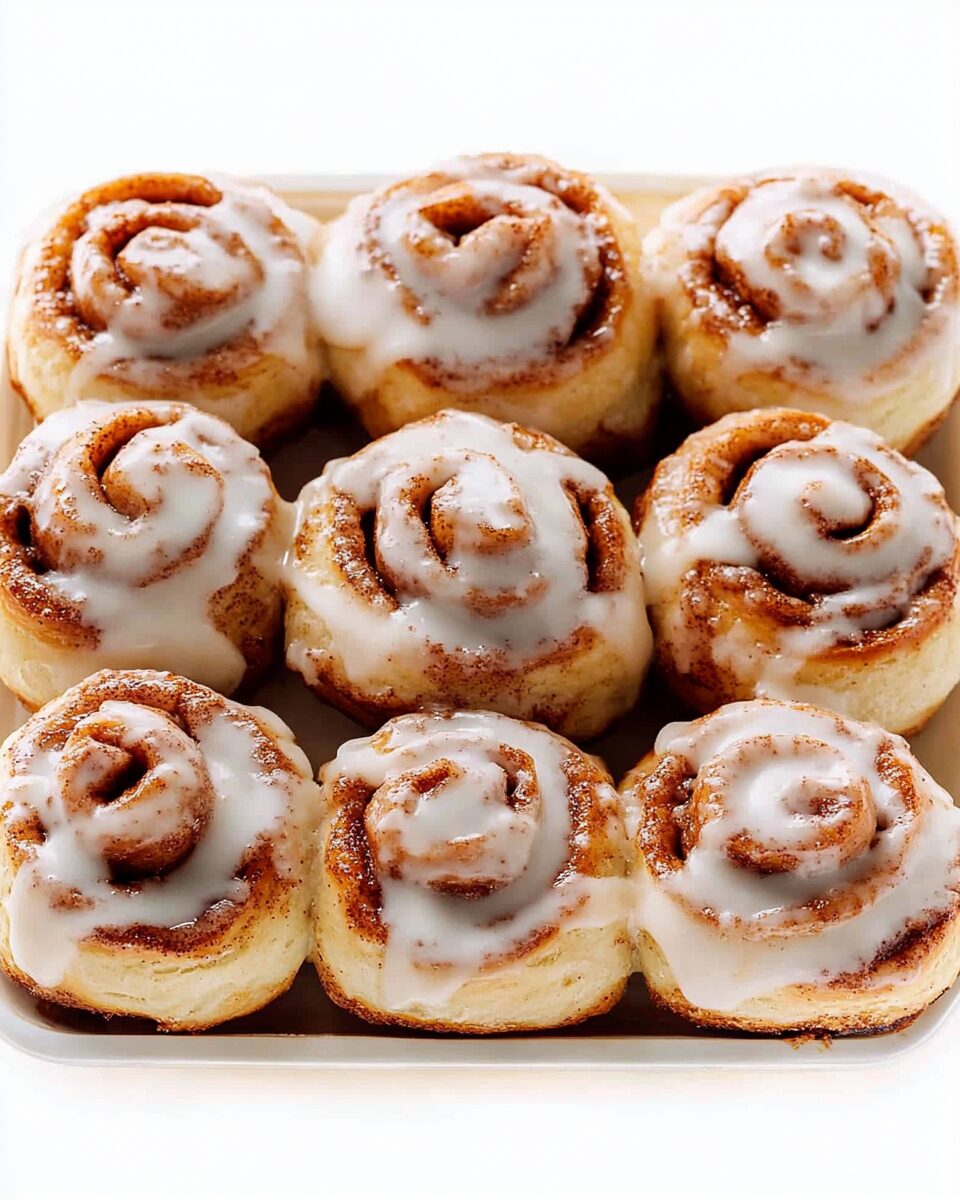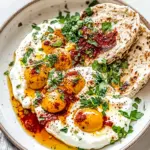There’s something incredibly nostalgic about the aroma of cinnamon and butter wafting through your home. These cinnamon rolls are the kind that make you pause and savor the moment. Made with a rich, yeast-based dough and a perfectly spiced cinnamon-sugar filling, they are delightfully soft and irresistibly gooey in all the right places.
Whether you’re baking for a weekend brunch, a holiday breakfast, or just to treat yourself, these cinnamon rolls deliver bakery-level deliciousness with every bite. Drizzled generously with a creamy vanilla glaze, they strike the perfect balance between sweet and comforting. Serve them warm and watch them disappear faster than you can say “more glaze, please!”
Full recipe:
Ingredients:
-
3/4 cup whole milk, warmed to 110°F
-
1 envelope (1/4 ounce) active dry yeast (approx. 2 1/4 tsp)
-
3 tbsp granulated sugar
-
3 large eggs, room temperature
-
2 1/2 tsp kosher salt
-
2 1/4 cups bread flour, plus more for dusting
-
1/3 cup + 1 tbsp whole-wheat flour
-
3 tbsp nonfat dry milk powder
-
2 3/4 sticks unsalted butter, room temp, cut into tablespoons
-
1 1/2 cups packed dark brown sugar
-
2 tbsp ground cinnamon
-
1 cup confectioners’ sugar
-
3 tbsp heavy cream (plus more if needed)
-
1 tsp pure vanilla extract
Directions:
-
Whisk together warm milk and yeast in a stand mixer bowl. Let sit for 10 minutes.
-
In a small bowl, combine sugar, eggs, and 1 1/2 tsp salt.
-
Add bread flour, whole-wheat flour, dry milk, and egg mixture to yeast. Mix with spoon until a shaggy dough forms.
-
Knead on medium speed with dough hook for 3 mins, then add 10 tbsp butter gradually on high speed. Continue kneading for 12 minutes until dough is tacky but pulls from sides.
-
Cover bowl and let rise until doubled, 30–45 mins.
-
Mix brown sugar, cinnamon, 1/2 tsp salt, and 12 tbsp softened butter to form the filling.
-
Roll dough on floured parchment into 12×15″ rectangle. Spread filling, leaving 1/4″ border.
-
Roll dough into a tight log. Freeze on baking sheet for 20 mins.
-
Grease a 13×9″ pan. Slice log into 12 equal pieces, arrange cut-side up in pan. Let rise uncovered for 40–50 mins.
-
Bake at 350°F for 25–30 mins until golden brown.
-
Cool on wire rack for 30 mins.
-
Whisk together confectioners’ sugar, cream, vanilla, and 1/2 tsp salt to make glaze. Drizzle over rolls and serve warm.
Prep Time: 1 hour 20 minutes | Cooking Time: 30 minutes | Total Time: 4 hours 10 minutes (including resting)
Kcal: ~420 kcal per roll | Servings: 12 rolls
What Makes This Cinnamon Roll Recipe Special
At the heart of this recipe is its dough—a buttery, yeast-risen base that is both soft and structured. Unlike many quick-fix recipes that skip the rising or kneading process, this version invests the time in proper fermentation and dough development. The result? Rolls that are feather-light on the inside and golden-brown on the outside. The wet, enriched dough contains eggs, milk, and a generous amount of butter, giving it an almost brioche-like texture that sets it apart from drier versions.
What’s also unique is the use of both bread flour and whole-wheat flour. This combination provides a balance of structure and flavor complexity. Bread flour lends strength, helping the rolls hold their shape while rising, while whole-wheat flour adds a hint of nutty depth.
The Art of the Perfect Filling
A cinnamon roll is only as good as its filling, and this recipe doesn’t cut corners. Instead of simply sprinkling cinnamon and sugar, it calls for a lush paste made from dark brown sugar, ground cinnamon, and softened butter. This mixture is more than just flavorful—it ensures the rolls remain moist and gooey in the center. The deep molasses notes of the dark brown sugar intensify during baking, producing that irresistible caramelized swirl in every bite.
Unlike versions that may have dry or uneven fillings, this smooth cinnamon-butter paste spreads evenly across the rolled-out dough, making sure every inch of the roll is infused with flavor.
Why Two Rising Phases Matter
One of the secrets behind these cinnamon rolls’ irresistible texture lies in the double-rise method. The first rise allows the yeast to ferment, developing not just airiness but also complex flavor notes. This dough smells distinctly yeasty and buttery even before baking—a sign that it’s perfectly proofed.
The second rise, done after the rolls are shaped and placed in the pan, helps develop their final shape and texture. It ensures the rolls expand enough to be soft, but still stay together tightly so the filling doesn’t leak out. Skipping either of these rises compromises the texture, often leading to dense or dry rolls.
Handling the Dough Like a Pro
For novice bakers, working with wet dough can feel intimidating, but with a bit of patience and practice, it becomes manageable. This recipe encourages bakers to mix the dough either with a stand mixer fitted with a dough hook or by hand. It even anticipates the moment when the dough looks “broken” as butter is added gradually—reassuring the cook that this stage is temporary and essential.
A short chill in the freezer after rolling and shaping helps firm up the dough, making it easier to slice cleanly without squishing. This is a professional technique often used in pastry kitchens, ensuring uniform spirals and a clean bake.
The Ideal Glaze to Finish
No cinnamon roll is complete without its crowning glory—a smooth vanilla glaze that drapes each roll in creamy sweetness. This recipe uses confectioners’ sugar, cream, vanilla extract, and just a pinch of salt to balance the sweetness. The result is a thick, luxurious glaze that sets lightly on top while seeping into the crevices of the rolls for an extra layer of indulgence.
What makes this glaze particularly versatile is its consistency. You can adjust the amount of cream to suit your preferences—thicker for a rich topping, thinner for more of a drizzled effect.
Perfect for Every Occasion
These cinnamon rolls are an ideal choice for weekend brunches, holiday breakfasts, special occasions, or simply treating yourself to a slow, cozy morning. They serve well both fresh from the oven and reheated the next day. In fact, many bakers find that the flavor deepens overnight, making leftovers something to look forward to.
The rolls are also freezer-friendly. After the initial shaping, you can freeze them for up to a month, then thaw and bake when needed. This makes them perfect for planning ahead or batch baking for guests and events.
Tips and Tricks for Best Results
For the fluffiest rolls, be sure to check your yeast is active. When mixed with warm milk, it should begin to dissolve and produce small bubbles within 10 minutes. If it doesn’t, your yeast may be expired.
Temperature matters throughout this process. Letting the dough rise in a warm, draft-free place speeds up proofing and helps develop the perfect texture. Many bakers find success by using an oven with the light on or placing the bowl near a warm stovetop.
When baking, positioning your pan in the center of the oven ensures even cooking. If you’re looking to add more complexity, consider incorporating chopped nuts, raisins, or even orange zest into the filling. For a more decadent twist, top with cream cheese frosting instead of vanilla glaze.
Customizing to Suit Your Taste
This recipe is a solid base that invites personalization. While the classic cinnamon roll is hard to beat, you can easily make it your own. Try adding toasted pecans for crunch, dried cranberries for tartness, or espresso powder for a mocha-cinnamon hybrid. You can also flavor the glaze with maple syrup, almond extract, or citrus juice to switch things up seasonally.
Gluten-free flour blends and dairy alternatives can be substituted, although the texture may vary slightly. Many bakers have found success using almond milk and plant-based butters, as well as replacing wheat flour with oat or gluten-free all-purpose flour.
Why It’s Worth the Effort
Yes, this cinnamon roll recipe takes time—over four hours from start to finish including proofing and cooling. But every minute is worth it. From the luxurious dough to the deep cinnamon swirl and the luscious glaze, each element is carefully designed to deliver the ultimate cinnamon roll experience. It’s not just about baking; it’s about creating a moment—whether that’s the joy of baking with family, surprising someone with a homemade breakfast, or simply indulging in something warm and sweet with your coffee.
Conclusion
In an era of shortcuts and quick fixes, this cinnamon roll recipe stands as a tribute to traditional, slow-made baking. It rewards patience with perfection—soft, buttery rolls that are beautifully golden on the outside and decadently gooey inside. Whether you’re a seasoned baker or just starting your journey, these rolls are a must-try.
They are more than a breakfast treat—they’re an experience, one that invites you to slow down, savor each bite, and perhaps even create a new weekend ritual.
If you’re searching for the ultimate cinnamon roll recipe that delivers every time, look no further. This is the one.






